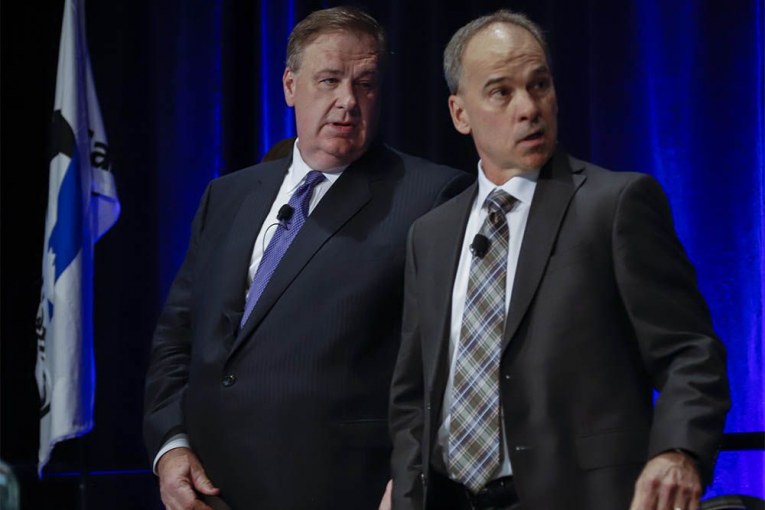
After withstanding an “extreme” second quarter that saw the company idle more than 100,000 barrels of oil per day at one point — the equivalent of sidelining a mid-sized petroleum producer — Canadian Natural Resources has resumed pumping almost all of its shut-in output.
Many other Canadian companies are doing the same, as the worst of the oilpatch downturn that began this spring now appears to be in the rear-view mirror.
Yet, even with oil prices stabilizing this summer around US$40 a barrel, Canadian Natural Resources president Tim McKay said the company has no plans to bolster its capital program for the rest of the year.
And it remains uncertain what next year will bring.
“We are staying on course with our $2.7-billion budget this year. We haven’t made any decisions on 2021, just because with COVID, it’s difficult to say at this time what the outlook would be,” McKay said in an interview Thursday.
The country’s largest petroleum producer reported second-quarter results Thursday that included a $310-million net loss.
During the April-to-June period, Canadian Natural produced an average of 1.17 million barrels of oil equivalent per day — down one per cent from the first quarter — even after it shut-in 120,000 bpd of conventional crude and oilsands output in May.
McKay said the company now has less than 10,000 bpd of the oil production idled. “With the improved price, we knew we could get a positive netback on it and (it) kept our people working,” he said.
Like much of the sector, Canadian Natural had to juggle an array of issues this spring, including a sharp nosedive in oil prices brought on by the COVID-19 pandemic, falling energy demand and a fierce price war between OPEC members and Russia.
Benchmark prices for West Texas Intermediate crude averaged just US$27.85 a barrel in the second quarter.
Faced with the prospect of hemorrhaging money on every barrel of oil pumped out of the ground, many western Canadian producers pivoted quickly to shut-in output, with an estimated one million barrels per day off-line at one point.
“What the results show, whether you’re in the U.S. or Canada or you’re a super major, is that those prices just aren’t sustainable,” said Jackie Forrest, senior director with ARC Energy Research Institute.
“We are seeing companies (now) say, ‘Hey, I am above cash costs and can make some profit by producing, and I am going to return those barrels to the market.’”
With prices snapping back into the $40-a-barrel range since mid-June, companies such as Canadian Natural Resources, Cenovus Energy and MEG Energy have all brought back production that was sidelined.
Oil prices have recovered more quickly than many anticipated, in part because of a rebound in demand for energy as economies restarted, and after production cuts in OPEC+ countries and in North America took hold.
“It was what I would call extreme. Obviously, COVID-19 put a lot of stress on our people, the pricing, obviously it put a lot of stress on the company,” McKay said of the second quarter, when oil prices sank to a negative US$37.63 a barrel on April 20.
McKay believes reacting quickly was key to withstanding such an intense storm. Aside from halting uneconomic production, the company chopped its 2020 capital budget by more than $1 billion in March, and cut operating costs.
Canadian Natural also decided to store some oil from its international operations and the oilsands at the end of the quarter due to low prices. If those barrels had been sold in the second quarter, the company would have produced another $60 million in cash flow.
Analyst Phil Skolnick of Eight Capital said the ability of Canadian Natural to put barrels into storage and wait for stronger prices, as well as continued efforts to lower operating costs in its oilsands operations, stood out.
Across the entire Canadian oilpatch, some heavy losses were reported by the largest producers during the turbulent quarter. Suncor Energy, for example, posted a net loss of $614 million, Imperial Oil lost $526 million and Husky Energy reported a $304-million loss.
But Skolnick believes the larger companies withstood the downturn better than expected.
“There were some painful numbers out there, but not as painful as we thought in April and May,” he said.
He estimates the Canadian industry still has at least 300,000 bpd that remains shut-in, mainly tied to oilsands projects now undergoing maintenance.
“As you look at the industry as a whole, the speed at which volumes shut-in certainly has industry coming out of this in better shape than we anticipated,” added Tudor Pickering Holt and Co. analyst Matt Murphy.
While more production is coming back online, there are no signs companies will start spending significantly more in the field.
Last week, the Petroleum Services Association of Canada released a forecast that trimmed the number of wells it expects to be drilled across the country this year by 10 per cent, down to 2,800, hitting lows that haven’t been seen in decades.
With the steep plunge in prices seen in March and April, and the high levels of debt that have been incurred, companies will remain reluctant to increase spending this year.
“There’s a fair bit of balance sheet repair to do . . . before growth through the drill bit becomes much of a consideration,” said Murphy.
The more encouraging news for the Canadian sector is that the second quarter is over and oil prices have stabilized, although the pandemic’s effect on future energy demand remains uncertain.
“The main message is $40 is a lot better than $27,” said Forrest. “But it’s still a very difficult situation, in that we are not going to see a lot of economic activity in drilling and capital expenditures in the province.”
Chris Varcoe is a Calgary Herald columnist.
You can read more of the news on source
